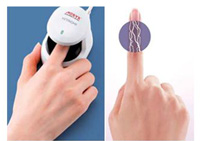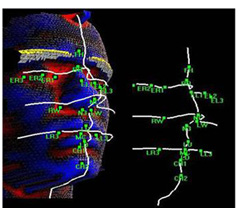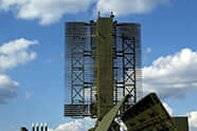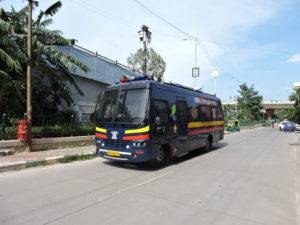Overview
In the November 2010 issue of the Homeland Security Tech Brief; we talked about Biometrics Solutions and how a basic Biometrics System works. In this issue we will be covering the latest technologies and techniques that are gaining increasing popularity in the Biometrics space.
The technologies that we will cover in this issue are:
- Finger-Vein Recognition
- 3-D Face Recognition using Structured Lighting
- Sensor Interoperability
Finger-Vein Recognition:
 |
| Source: www.m2sys.com |
A very recent advance in contactless biometric sensor technology is finger-vein recognition. Finger-vein technology is accurate, hard to forge, and helps solve many privacy concerns.
Near-infrared light (which is invisible to the naked eye) is directed onto the finger and is absorbed by the hemoglobin of the blood in the veins. Using the infrared light to illuminate the veins, an image is generated of the unique pattern of veins, which is then captured by a sensor placed a few centimeters under the finger.
Finger-vein pattern recognition meets the criteria, associated with biometrics systems, of convenience, accuracy, and privacy:
- Convenience: Because subcutaneous veins provide clear, yet hidden features, these patterns are easily comparable. It’s quite simple for the biometric algorithm to scan finger-vein patterns and perform fast and smooth authentication.
- Anti-spoofing: Finger-vein technology is extremely difficult to duplicate. Because vein patterns used for authentication are hidden to the eye, the technology is very secure from spoofing. When anyone attempts to spoof, or fool, a biometric system, the starting point is typically obtaining a biometric sample, or copy, to use as the basis of their spoof attempt. This can include such things a picture of a face or a lifted fingerprint image from a glass. Since vein patterns are not visible to the eye and not capable of leaving traces behind, the technology is highly resilient to spoofing.
- Precision: Finger-vein patterns also have very low false positives (< .0001%, Hitachi) and low false negative levels (<.01%, Hitachi). Like iris and retina biometrics, finger-vein patterns can distinguish between identical twins. Also, because adult finger-vein patterns don’t change with age – and when properly illuminated are crisp and distinct – it’s straightforward for devices to tell patterns apart. In addition, external sweat, dust, and dirt and everyday cuts and abrasions have been shown to have minimal impact on the accuracy of finger-vein systems
3D Face Recognition
Traditional 2D face recognition systems are based on standard photo or video pictures (intensity images) – these are not ground-based measurements and are highly sensitive to changes in ambient lighting or view angle. In addition, they are sensitive to changes in scale, facial accessories (make-up, glasses, beards) and aging of the user.
 |
| Source: www.l1id.com |
The advent of 3D face recognition has made this technology accurate, fast and as simple as fingerprint recognition.
3D face biometrics is based on anthropometric data – precise measurements of cranial structure and rigid tissues. The 3D biometric template (feature vector) is extracted from extremely precise geometric data (sub-millimeter measurements) about the cranial curvature is those areas where rigid tissues are most visible (for example eye sockets, superciliary arches, chin zone, the bridge of a nose). These areas are the most unique and are unchanging over time, and therefore robust to aging or weight changing in the subject.
The structured light approach to 3D face recognition, eliminates concerns about poor lighting conditions, structured light 3D technology uses its own light source. Structured light 3D face-readers shine an invisible near infrared pattern of a grid on a user’s face and then maps the geographic pattern of the face based on the distortions it causes in the grid pattern.
The structured light approach can also accommodate a number of facial positions, making the verification process simple for users who need to only pause in front of the reader on their way in.
3D face recognition using structured light approach has a number of unique advantages:
- Thoroughness: The semantic analysis of the face permits the use of “smart” algorithms for facial camouflage. For example, in the event of the user growing a beard, the expected shape of the chin will be deformed by the hair and the 3D reconstruction will show a rough area of the face. The algorithms recognize that the user has grown a beard, and automatically shifts the emphasis of recognition (matching) to the alternate reliable areas of the face. The same system is used for eye glasses/spectacles, where the algorithms register a non-concave area around the eyes.
- Anti-spoofing: 3D face recognition cannot be spoofed by video or photograph images. In addition, it is extremely difficult to fool the system with 3D dummy or mask, as a precise stereo-lithographic model is required with the same sub-millimeter geometric measurements. Also, the light pattern in the near infra-red range is reflected and diffracted in a specific manner against human skin.
- Robustness: The 3D face recognition technology is more robust to different view angles between the enrollment and captured shots, with robust recognition of up to 30° from the frontal position. Therefore, this 3D approach has the potential to work with higher accuracy in real world environments.
Sensor Interoperability
There are a variety of fingerprint image capture devices, or fingerprint sensor technologies, available in the market today; each with different merits. While some sensors are ideal in certain conditions, they may not be suitable, or even acceptable, in another. For example, sensors designed to withstand harsh environments, such as rain, might be the ideal solution for fingerprint readers placed outside in areas that experience extreme weather conditions. The same sensors, however, may not make a suitable solution for an indoor environment, since they are a more expensive alternative. The extreme cost pressure placed on a notebook deployment is driving the sensor industry to smaller sensors, such as the swipe sensors. These would not be effective for all outdoor environments.
These issues have brought out the need for sensor interoperability in the biometrics space. Sensor interoperability is possible using a pattern-based core algorithm that supports a variety of sensors and gives companies the freedom to create best of breed environments that incorporate a number of different readers. It also enables future growth and gives companies the ability to introduce new readers as needed.
Sensor Interoperability is ideal for organizations that deploy different types of sensor technology.
- Single Enrollment for different sensors: Sensor interoperability makes it possible to accurately match biometrics that are enrolled on one type of sensor and presented for verification on a variety of other sensors. Thus, enrollment can be done using readers that incorporate sensors manufactured by numerous vendors even though various sensors create significantly different images. These differences can include the area scanned, the number of dots per inch (DPI) or resolution of the biometric that is captured; the type or level of distortion created; the characteristics of the background noise present in the image; and the contrast and brightness of the image.
- Binds heterogeneous environments into a cohesive system: Sensor interoperability gives businesses the power to create best-of-breed solutions using different readers for different applications, without having to re-enroll employees for each of the readers. This also allows them to accommodate a variety of sensors that emerge when different departments or individuals make purchasing decisions on different technologies, for reasons of cost, performance or just plain preference.
Conclusion
Innovations made in the last few years in pattern-based biometric recognition and 3D face recognition technology has made it possible for biometric technology to meet the needs of public and private organizations looking for enhanced identity and access management solutions.
Mistral Solutions, has partnered with L-1 ID, among the rising 10 of 2009 – a list of companies that promise to grow quickly in coming years because of either recent contract wins or their overall positioning within growing areas of homeland security – to provide the industry’s most advanced multi-modal biometric platforms for finger, face, palm and iris recognition, to the Indian market. Solutions for L-1 ID are used by most U.S. states and Canadian provinces and across 25+ countries. These solutions provide a circle of trust around all aspects of an identity and the credentials assigned to it. This includes proofing, enrollment, issuance and usage. For more information, visit http://www.mistralsolutions.com or email us at hs@mistralsolutions.com .



